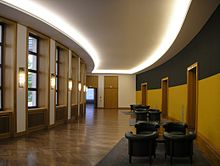Heinrich Wolff (architect)
Heinrich Wolff (born December 30, 1880 in Neurode in Silesia ; † June 20, 1944 in Berlin-Buch ) was a German architect and, as Reichsbank construction director, head of the construction office of the Deutsche Reichsbank .
Life
From 1902 to 1904, Wolff studied architecture at the Royal Technical University of Berlin-Charlottenburg. During his studies he became a member of the Academic Association Motiv . In 1904 he enrolled at the TH Munich. In 1906 he passed the examination as a graduate engineer in Berlin. From 1908 to 1911 Wolff received training as a government master builder. In 1919 he married Elisabeth Wolff, b. Röther.
In 1924 Wolff became head of the Reichsbank construction office. In 1926 the entire building management of the Reichsbank was taken over. In 1939 he was appointed department head at the Reichsbank directorate. In 1944, Wolff received an appointment as professor by Hitler.
Effect and works
His best-known building is the new building of the “Reichsbank Extension” in Berlin (1934–1940, today the seat of the Foreign Office , before 1990 the Central Committee of the GDR SED). The 1933 competition among thirty selected well-known German architects, including z. Ludwig Mies van der Rohe and Walter Gropius , for example , produced mostly designs in a modern style (cf. Neues Bauen , Bauhaus , Classical Modernism ) that did not correspond to the National Socialist cultural ideals.
The numerical ratio between the conservative and modern architects invited was roughly equal. The designs of all participants did not differ as much as one might have expected. What all participants had in common was the complete abandonment of traditional forms that were common for banks in the 19th century and up to the beginning of the First World War ; all renounced ornamentation or decoration. A typical National Socialist representation architecture did not yet exist. According to the application documents, the award of an order to the winner of the competition was never thought of, the winner was only supposed to work for the Reichsbank construction office. Ultimately, Wolff's design, submitted out of competition, was implemented directly. Against this background, Hitler's often rumored personal influence must be reassessed. The implemented design by Wolff had moderately modern features.
In 1919 Wolff designed the Stahlhelmdenkmal on the Spandau cemetery In den Kisseln in Falkenhagener Feld , and in 1923 together with city planner Karl Elkart the memorial for the fallen soldiers of the 5th Guards Regiment on foot , also in Berlin-Spandau.
The various buildings of the Reichsbank construction office, which were created according to drafts or under the direction of Heinrich Wolff, include z. B .:
- 1925: Tomb for the President of the Reichsbank Rudolf Havenstein in Berlin-Dahlem, on the St. Anne's cemetery
- 1926–1928: Reichsbank headquarters in Königsberg (East Prussia) , Schlossplatz
- 1927: Reichsbank branch in Erlangen
- 1928: Civil servants' settlement in Berlin-Schlachtensee , Spanische Allee / Breisgauer Strasse / Dubrowstrasse (employee: Rudolf Ullrich)
- 1927–1929: residential and commercial building, Jüdenstrasse 41, Berlin-Spandau
- 1928–1930: Reichsbank main office in Dresden , Akademiestrasse
- 1931–1933: Reichsbank headquarters in Frankfurt am Main , Taunusanlage 4/5
- 1934–1936: Reichsbank main office in Lübeck , Holstentorplatz
- 1936–1937: Reichsbank office Koblenz , Neustadt 6/7
- 1936–1940: Reichshauptbank in Berlin
- 1939–1940: Reichsbank branch Schwabach , Südliche Ringstrasse 7
In total, the Reichsbank construction office completed over 100 buildings between 1922 and 1938. These buildings were mostly taken over by the newly founded state central banks after 1945 in the Federal Republic of Germany, provided they survived the Second World War undamaged .
Frequently Heinrich Wolff is erroneously as co-editor a picture book about the New Reich Chancellery of Albert Speer called.
literature
- Peter Kroos: Heinrich Wolff and the buildings of the Reichsbank building office 1918–1945. Dissertation, University of Dortmund, Chair for Monument Preservation and Building Research, 2005.
Individual evidence
- ↑ The Black Ring. Membership directory. Darmstadt 1930, p. 41.
- ↑ Residential and commercial building Jüdenstrasse 41 . State Monument Office Berlin. Retrieved February 7, 2020.
Web links
| personal data | |
|---|---|
| SURNAME | Wolff, Heinrich |
| BRIEF DESCRIPTION | German architect; As Reichsbank construction director, he was the head of the construction office of the Deutsche Reichsbank |
| DATE OF BIRTH | December 30, 1880 |
| PLACE OF BIRTH | Neurode, today Nowa Ruda in Silesia |
| DATE OF DEATH | June 20, 1944 |
| Place of death | Berlin book |






